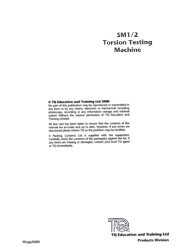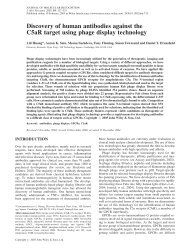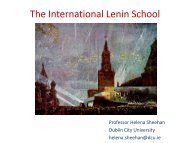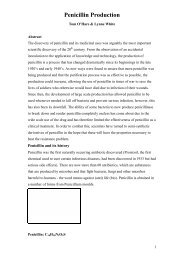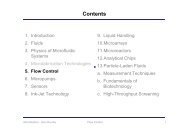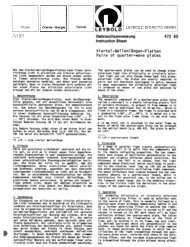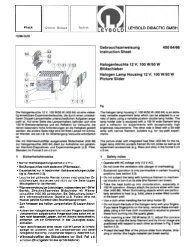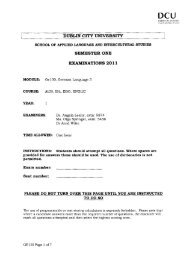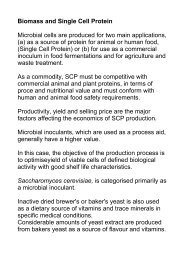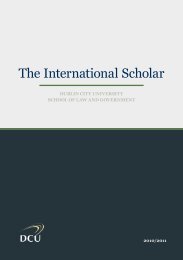Marine Glossary - DCU
Marine Glossary - DCU
Marine Glossary - DCU
You also want an ePaper? Increase the reach of your titles
YUMPU automatically turns print PDFs into web optimized ePapers that Google loves.
<strong>Marine</strong> <strong>Glossary</strong><br />
(Compiled from the following on-line resources: http://oceanlink.island.net/, http://www.mbari.org/, http://www.env.gov.bc.ca/ )<br />
A<br />
abaxial<br />
abciss<br />
abiotic factor<br />
abyssopelagic Zone<br />
accessory<br />
acropetal<br />
aculeate<br />
acute<br />
adaptation<br />
adaxial<br />
adherent<br />
adsorption<br />
adventitious<br />
akaryotic<br />
akinete<br />
alginate<br />
alien species<br />
situated away from main axis, often on underside of branch<br />
detach, separate from main structure<br />
The physical, chemical and other non-living components of the environment that an organism lives<br />
in. These factors include all aspects of climate, geology, and atmosphere that affect ecological<br />
systems. Compare biotic factor.<br />
'Abysso' meaning 'no bottom', this zone of the ocean begins 4000 m below the surface of the ocean<br />
and extends down to the sea floor. This zone is home to a variety of unique critters that are specially<br />
adapted to the inhospitable conditions that these depths create. Visit the Abyssopelagic Zone on<br />
OceanLink to learn about life in the abyss.<br />
subsidiary, like a non-chlorophyll pigment<br />
from the base to the apex<br />
bearing a sharp point<br />
sharply pointed<br />
Any change in the structure or function of an organism which makes it better suited to its<br />
environment. For example, the torpedo body shape of a tuna allows for fast swimming in the open<br />
ocean.<br />
situated toward the axis, often on the upper side of branch<br />
closely attached<br />
A process in which solids or liquids attract and hold other solids, liquids, or gases in a surface film,<br />
without chemically combining with them.<br />
irregular, secondarily produced, not a primary part<br />
without a true nucleus<br />
enlarged cell with food reserves and thick cell wall which may undergo dormancy, e.g. in<br />
Cyanobacteria<br />
salt form of alginic acid, a polysaccharide colloid produced in walls of Phaeophyceae made of<br />
mannuronic acid and guluronic acid units<br />
A plant or animal that has been introduced by humans to a location outside its native range. Also
allele<br />
alloparasite<br />
alternate<br />
amorphous<br />
amyloplast<br />
anadromous<br />
anaerobic<br />
anisogamy<br />
anterior<br />
antheridium<br />
apical<br />
apogamy<br />
apomeiosis<br />
aquaculture<br />
arcuate<br />
articulated<br />
autotroph<br />
autotrophic<br />
auxiliary cell<br />
axis<br />
called introduced, non-native, exotic and invasive species.<br />
One of the alternative forms of a particular gene. Each gene is comprised of two alleles, one<br />
inherited from the father and one from the mother. However, within a population, many alleles may<br />
exist for one gene. Hair colour in humans is a great example! See also genes.<br />
parasite not related to its host<br />
branched at different levels on opposite sides of main axis<br />
lacking definite structure or shape<br />
colorless organelle related to starch production<br />
Fish that must ascend rivers and streams from the sea in order to breed.<br />
living without free oxygen, in a reducing atmosphere<br />
reproduction by motile gametes that differ in morphology or behavor<br />
in front, or toward the front<br />
cell that produces motile male gamete<br />
at or near the apex or top, distal<br />
development of an organism without gamete fusion (fertilization)<br />
nuclear division without meiosis<br />
The controlled cultivation and harvest of aquatic animals or plants, such as finfish (e.g., salmon),<br />
shellfish (e.g., clams, oysters), and edible seaweeds.<br />
curved like a bow, crescent-shaped<br />
jointed or segmented, e.g. Calliarthron or Halimeda<br />
An organism that synthesizes organic molecules from inorganic starting materials through<br />
photosynthesis or chemosynthesis. Autotrophs are ecologically important as primary producers as<br />
they ultimately provide energy for all heterotrophic organisms. See also chemosynthesis,<br />
photosynthesis; compare heteroptroph.<br />
capable of producing its own food<br />
cell in post-fertilization development in the Rhodophyta which receives the diploid (2N) zygote<br />
nucleus and then develops the gonimoblast filaments<br />
main stem or central line of development on which secondary or side branches are borne<br />
B<br />
ballast water<br />
Water carried by a ship to improve its stability when it is lightly loaded. It is normally discharged into
asal<br />
baseline thematic mapping (BTM)<br />
basipetal<br />
bathymetry<br />
bathypelagic zone<br />
benthic<br />
benthic<br />
benthic<br />
biaxial<br />
biflagellate<br />
bifurcate<br />
bilateral<br />
bioaccumulation<br />
bioaccumulation<br />
biodiversity<br />
biodiversity<br />
biogeoclimatic ecosystem<br />
classification (BEC)<br />
biological controls<br />
biological oxygen demand (BOD)<br />
the ocean when the ship is loaded with cargo.<br />
near point of attachment to substratum<br />
A digital integration of satellite imagery and land-use, land-cover, and topographic data to produce<br />
an “image map” with contour lines and vector planimetry information.<br />
in direction from apex to base<br />
The depth of water in the ocean as it relates to the topography or features of the ocean floor.<br />
The zone of the ocean that extends from 1000m to 4000m below the surface of the ocean. Visit the<br />
Bathypelagic Zone on OceanLink for pictures and cool facts about life at this depth.<br />
Organisms that live on or in the sediment at the bottom of aquatic ecosystems such as lakes, rivers,<br />
and the ocean.<br />
attached to substratum, not planktonic<br />
Refers to organisms that live on or in the ocean bed. Benthic epifauna are organisms that live on the<br />
ocean floor or upon bottom objects sch as sea anemones and barnacles, whereas benthic infauna<br />
are organisms that live within the surface sediments such as clams and worms. Compare pelagic.<br />
having two axial cell rows<br />
having two flagella<br />
divided into two parts, forked<br />
having two sides<br />
An increase in the concentration of a chemical in a biological organism over time, compared to the<br />
chemical’s concentration in the environment. Compounds accumulate in living things if they are taken<br />
up and stored faster than they are broken down or excreted.<br />
The process whereby pollutants are taken up, retained and concentrated in the cells of plants and<br />
animals.<br />
The variety and abundance of life, including ecosystems, communities, and the genetic composition<br />
of species. Also called biological diversity.<br />
The variation in life on Earth reflected at all levels, from various ecosystems and species, to the<br />
genetic variation within a species. See also ecosystem diversity, species diversity, genetic diversity.<br />
A classification system in British Columbia that distinguishes terrestrial zones based on climate,<br />
soils, and dominant vegetation.<br />
Using natural enemies of a particular species, usually predators and pathogens, to control<br />
population.<br />
A measure of the amount of oxygen required for bacteria to break down organic matter (e.g., sewage
ioluminescence<br />
biomagnification<br />
biotic factor<br />
biseriate<br />
bisporangia<br />
blade<br />
blue listed species<br />
boreal<br />
branchlets<br />
bulbous<br />
by-catch [fishery]<br />
effluent) in water. If BOD is too high, fish and other aquatic organisms are deprived of the oxygen<br />
they need for survival.<br />
Meaning living (bio) light (luminescence) is the light produced by living organisms and the emission<br />
of such biologically produced light. Also commonly referred to as 'phosphorescence'. For more info,<br />
visit the Salty Science Algae Page.<br />
The process that results in the accumulation of a chemical in an organism at higher levels than are<br />
found in its food. It occurs when a chemical becomes more and more concentrated as it moves up<br />
through a food chain<br />
A living component of the environment which arises from and affects living organisms (distinct from<br />
physical factors). For example, the interaction between predators and prey is a biotic interaction.<br />
Compare abiotic factor.<br />
arranged in two series or rows<br />
sporangia that divides to produce 2 spores perhaps by mitotic division, in Corallinales and some<br />
other Rhodophyta<br />
flat, leaf-like structure<br />
A species classified by the BC Conservation Data Centre as not immediately threatened but of<br />
concern because of characteristics that make it particularly sensitive to human activities or natural<br />
events.<br />
northern, colder waters<br />
smallest pigmented branches or secondary branches, ramuli<br />
swollen<br />
Discarded catch plus incidental catch. Discarded catch is the portion of the fishery catch that is<br />
returned to the sea because of economic, legal, or personal considerations. Incidental catch is<br />
retained catch of non-targeted species.<br />
C<br />
calcareous<br />
callus<br />
capitate<br />
carcinogen<br />
carpogonium<br />
calcified, hardened with lime (calcium carbonate), e.g. in the Corallinales<br />
abnormal, thickened part often a reaction of wounding<br />
shaped like a head, swollen at one or both ends<br />
A substance that may cause cancer in animals or humans.<br />
haploid (N) female sexual structure in Rhodophyta consisting of single cell and its extension, the
trichogyne<br />
carposporangia<br />
single celled structures that produce the diploid (2N) carpospores on the parasitic carposporophyte<br />
in Rhodophyta<br />
carpospore<br />
non-motile diploid (2N) spores formed on parasitic carposporophyte stage of the Rhodophyta, which<br />
germinate to form tetrasporophyte stage<br />
carposporophyte<br />
the diploid (2N) stage of Rhodophyta which develops after fertilization of the carpogonium<br />
cartilaginous<br />
fleshy, but firm or even tough and leathery<br />
CCCMA<br />
Canadian Centre for Climate Modelling and Analysis (located at the University of Victoria).<br />
CDC (B.C. Conservation Data The provincial government office that tracks species and ecosystems that are in some danger of<br />
Centre)<br />
disappearing from British Columbia. The CDC annually publishes the provincial red and blue lists.<br />
centrifugal<br />
developing from the center outward<br />
centripetal<br />
developing inward toward the center<br />
certification [of products for A process whereby an independent, third-party auditing body conducts an inspection and awards a<br />
sustainability]<br />
certificate using independently developed standards and objectives.<br />
chart datum<br />
The Canadian Hydrographic Chart Datum (CHCD) is the lowest tide that can be expected in a given<br />
locality considering gravitational effects alone. Even lower tides may occur rarely if strong or<br />
persistent winds and storm surges work to further lower the water. The chart datum is used as a<br />
reference point for measuring water level at tide gauge stations on the coast.<br />
chemosynthesis<br />
The process whereby chemical energy is used to make organic compounds from inorganic<br />
compounds. One example is the oxidation of ammonia to nitrite by nitrifying bacteria. Compare<br />
photosynthesis.<br />
chloroplast<br />
double-membrane bound organelle inside the cell with photosynthetic pigments on thylakoids<br />
chromosome<br />
A linear sequence of genes wound up with proteins into a single unit that is found in the nucleus of<br />
cells. See also DNA, genes.<br />
clone<br />
a population asexually derived from a single cell or individual<br />
CO2 equivalent The amount of CO2 that would cause the same effect as a given amount or mixture of other greenhouse gases.<br />
coenocytic<br />
multinucleate, without cell crosswalls, composed of multinucleate cells or segments<br />
colony<br />
aggregation or loose organization of similar cells (or organisms) which developed from a single<br />
original cell or organism, each capable of independence from the rest of the colony<br />
commensal<br />
organisms living in, on or with another, without any particular advantage or harm from the<br />
relationship<br />
community<br />
A naturally occurring group of plants and animals that live within a certain environment and interact
compensation point<br />
compound<br />
compressed<br />
concave<br />
conceptacle<br />
congener<br />
conjugation<br />
conservation<br />
conservation biology<br />
conservation covenant<br />
contamination<br />
convergent evolution<br />
convex<br />
corridor<br />
cortex<br />
cortical<br />
COSEWIC (Committee on the<br />
Status of Endangered Wildlife in<br />
Canada)<br />
cosmopolitan<br />
with each other. Communities are often defined by a dominant species (e.g. kelp forest community)<br />
or the major physical characteristics of the area (e.g. mud flats).<br />
conditions where respiration is in balance with photosynthesis, with generally no net gas exchange,<br />
in algae usually related to habitat depth<br />
having multiple parts or branches, not simple<br />
flattened<br />
saucer-shaped, with surface that curves inward<br />
cavity or chamber containing reproductive structures with opening to the surface for release, e.g. in<br />
Corallinales and Fucales<br />
A term in chemistry that refers to one of many variants or configurations of a common chemical<br />
structure. Although similar, congeners may have different toxicological properties and fates in the<br />
environment.<br />
special form of isogamy where the reproductive protoplasts of two organisms form a common tube<br />
and fuse together, e.g. in Zygnemataceae<br />
The protection of wild species and their ecosystems.<br />
A field of science that deals with threats to biodiversity. The goals of conservation biology are to<br />
investigate human impacts of biodiversity and to develop approaches to prevent extinction through<br />
stewardship of entire biological communities.<br />
A legal agreement that specifies the ways in which a piece of land can be used. A conservation<br />
covenant is incorporated into the land deed and protects the land in perpetuity.<br />
Substances, including those found naturally, that are present at concentrations above natural<br />
background levels, or whose distribution in the environment has been altered by human activity.<br />
The development of similar structures in organisms that do not share recent common ancestor (e.g.<br />
eyes of squid and humans). Compare divergent evolution; see also evolution.<br />
having surface that curves outward<br />
An area of intact habitat that allows wildlife to move in relative safety from one place to another.<br />
tissue lying between the epidermis layer and the central medulla tissue<br />
relating to the cortex<br />
A national committee of experts that assesses and designates which wild species are in some<br />
danger of disappearing from Canada.<br />
found in many parts of the world
costate<br />
cover cells<br />
critically endangered<br />
crosswall<br />
cruciate<br />
cryptic colouration<br />
cryptostoma<br />
cuneate<br />
cuticle<br />
cystocarp<br />
cystocarpic<br />
cytokinesis<br />
ribbed<br />
sterile cells cut off from during the formation of tetrasporangia in Rhodophyta<br />
IUCN classification for a species for which the best available evidence shows that it is facing an<br />
extremely high risk of extinction in the wild.<br />
end wall of a cell in a filament<br />
generally cross-shaped; in the Rhodophyta, the type of division where tetrasporangium divides in<br />
two planes at right angles to each other<br />
To protect themselves against predators, many animals acquire colouring and markings to match<br />
and conceal them in their usual surroundings. For example the nudibranch (sea slug), Rostanga<br />
pulchra, is practically indiscernible from the red sponges on which it lays its eggs.<br />
cavity open to surface that contains hairs or pariphyses, e.g. in Fucales<br />
wedge shaped, triangular with acute angle downward<br />
structureless layer on outer surface of some plants<br />
the carposporophyte and surrounding envelop of haploid (1N) female gametophyte tissue (or<br />
pericarp) in the Rhodophyta<br />
bearing cystocarps, signaling a fertilized female gametophyte in the Rhodophyta<br />
process of cell division, as opposed to nuclear division<br />
D<br />
decomposer<br />
decomposition<br />
desmid<br />
detritus<br />
detrivore<br />
diatom<br />
diatomaceous earth<br />
An organism which gains energy by breaking down the final remains of living things. Predominantly<br />
bacteria and fungi, decomposers are important in freeing the last of minerals and nutrients from<br />
organics and recycling them back into the food web. See also decomposition; compare detrivore.<br />
The biochemical process where biological materials are broken down into smaller particles and<br />
eventually into basic chemical compounds and elements. See also decomposer.<br />
green algae that have conjugation of non-flagellate, amoeboid gametes<br />
Dead organic matter of plant or animal. See also detrivore.<br />
An organism that feeds on large bits of dead and decaying organic matter. What detrivores leave<br />
behind is used by decomposers. Crabs and seabirds are examples of detrivores. Compare<br />
decomposer; see also detritus.<br />
member of Bacillariophyceae<br />
siliceous geological deposits made up of diatom frustules
diatoms<br />
diffuse growth<br />
dioecious<br />
dioxins and furans<br />
diploid<br />
disturbed environment<br />
diurnal<br />
divergent Evolution<br />
DNA (Deoxyribonucleic acid)<br />
Microscopic algae with plate-like structures composed of silica.<br />
generalized growth, not localized at apex or base<br />
(two houses) producing male and female gametes on different individuals or clones<br />
Two families of chlorinated organic compounds that can be formed as by-products of activities such<br />
as pulp bleaching and waste incineration. Both can persist in the environment for many years and<br />
some forms are highly toxic.<br />
having twice the basic haploid number of chromosomes<br />
Alteration of part or all of a living community from natural or human activity. Storms, landslides and<br />
El Ninos are examples of natural events; clearcutting, pollution, and harbour dredging are examples<br />
of human-caused disturbance.<br />
having daily periodic cycle, e.g. endogenous circadian rhythm<br />
The evolution of one species to a number of different forms. Compare convergent evolution; see also<br />
evolution.<br />
The primary genetic material of a cell that makes up genes and chromosomes. See also genes,<br />
chromosome.<br />
E<br />
ecological niche<br />
ecology<br />
ecoregion classification<br />
ecosection<br />
ecosystem<br />
ecosystem<br />
The role a plant or animal plays in its community. The niche of an organism is defined by what it<br />
eats, its predators, salt tolerances, light requirements etc. Two species cannot live stably in the same<br />
habitat if they occupy identical niches.<br />
The study of the physical and biological interactions between an organism and its natural<br />
environment.<br />
A classification system in B.C. that describes areas of the province with similar climate, physical land<br />
and water features, vegetation, and wildlife potential. The classification has five levels from broadest<br />
to narrowest: ecodomain, ecodivision, ecoprovince, ecoregion, and ecosection. See Demarchi 1996<br />
for more details. See also, <strong>Marine</strong> Ecosystem Classification.<br />
The finest scale in the Ecoregion Classification system. Forty ecosections make up the coastal and<br />
marine region of B.C..<br />
Plants, animals, and the physical environment (water, air, soil, etc.) interacting in a given area.<br />
A community of plants, animals and other organisms that are linked by energy and nutrient flows and<br />
that interact with each other and with the physical environment. Rain forests, deserts, coral reefs, and
ecosystem diversity<br />
ecotourism<br />
ecotype<br />
ectocarpin<br />
ectoparasite<br />
effluent<br />
ejectosome<br />
El Niño Southern Oscillation<br />
(ENSO)<br />
endangered<br />
endangered<br />
endemic<br />
endemic<br />
endocrine<br />
endocytic<br />
endophytic<br />
endozoic<br />
ENSO<br />
environment<br />
epicone<br />
epilithic<br />
epilithic<br />
grasslands are examples of ecosystems.<br />
The diversity of biological communities and their physical environment. Diversity is determined by<br />
the species composition, physical structure and processes within an ecosystem. This is the highest<br />
level of biodiversity. See also biodiversity; compare species diversity, genetic diversity.<br />
Nature-based tourism that is ecologically sustainable.<br />
A subgroup within a species that has developed distinct physical or behavioural characteristics in<br />
response to its local environment that persist even if individuals are moved to a different environment.<br />
sex hormone produced by female gametes of Ectocarpus that causes male gametes to cluster near<br />
source of the hormone<br />
parasite living outside its host<br />
Industrial or urban waste discharged into the environment.<br />
type of ejectile organelle found in cryptomonads<br />
See ENSO<br />
A species facing imminent extirpation or extinction very soon (COSEWIC).<br />
A species or ecosystem that is so reduced or delicate that it is threatened with or on the verge of<br />
extinction. Compare extinct, extirpated, threatened, vulnerable.<br />
A species native to, and restricted to, a particular geographical region.<br />
An animal or plant species that naturally occurs in only one area.<br />
System of the body that releases hormones into the blood stream or lymph system. These hormones<br />
control growth, metabolism, mood, and reproduction and influence almost every cell and organ in the<br />
human body.<br />
living inside a cell<br />
living within tissues of host plant or alga<br />
living with tissues of animal host<br />
El Niño Southern Oscillation, an interannual variation in climate related to large-scale shifts in<br />
tropical atmospheric pressure manifested by El Niño and La Niña events.<br />
All of the physical, chemical, and biological factors in the area where a plant or animal lives.<br />
part of dinoflagellate cell anterior to the cingulum<br />
living on rock or stone<br />
A term for organisms that live attached to rocks. Latin translation: epi = upon, lith = rock. This term is<br />
general to terrestrial and marine habitats, ie. some lichens are epilithic.
epipelagic zone<br />
epiphytic<br />
epitheca<br />
epizoic<br />
escapement<br />
estuary<br />
eukaryotic<br />
euphotic zone<br />
euryhaline<br />
eutrophic<br />
eutrophication<br />
eutrophication<br />
evolution<br />
exotic species<br />
external threat [to protected areas]<br />
extinct<br />
extinct<br />
extirpated<br />
extirpated<br />
See photic zone.<br />
living on a plant<br />
the epivalve and epicingulum of a diatom frustule or cell wall<br />
living on an animal<br />
The number of fish that escape commercial or recreational fishing and return to spawn; these make<br />
up the expected breeding population.<br />
The mouth of a river where fresh and salt water meet and mix. Estuaries tend to be highly productive<br />
environments.<br />
having membrane-bound organelles<br />
that upper layer of the ocean that receives sufficient light for photosynthesis to occur, to depths of<br />
perhaps 180 feet in Monterey Bay<br />
tolerant of range of salinities<br />
nutrient-rich<br />
A process by which over-enrichment of a water body with nutrients results in excessive plant growth<br />
and oxygen depletion.<br />
Enrichment of a water body with nutrients, resulting in excessive growth of phytoplankton,<br />
seaweeds, or vascular plants, and often depletion of oxygen.<br />
The process by which a species' structural and behavioural characteristics change over many<br />
generations, sometimes in response to changes in environmental conditions. "New" species develop<br />
in this way. For example, scientists think that whales gradually evolved from land animals. See also<br />
convergent evolution, divergent evolution.<br />
See alien species<br />
Something occurring outside the protected area boundary that threatens ecosystems and<br />
biodiversity within the protected area. For example, roads, urban development, tourist infrastructure,<br />
forestry, mining, agriculture.<br />
A species that no longer exists.<br />
A species which no longer exists. The Stellar sea cow is an example of a species which once lived<br />
on the Pacific's East Coast and is now extinct. Compare extirpated.<br />
A species no longer existing in the wild locally, but which occurs elsewhere.<br />
A species no longer existing in Canada, but occurring elsewhere on Earth. Compare extinct.<br />
F
facultative<br />
fecal coliform bacteria<br />
fertilization<br />
fish population<br />
fish stock<br />
floridean starch<br />
flux<br />
food chain<br />
food chain<br />
food web<br />
food web<br />
fountain growth<br />
fragmentation<br />
fragmentation<br />
exhibiting some ability or function under some environmental conditions but not under others<br />
Bacteria found in the intestinal tracts and feces of warm-blooded animals.<br />
The joining or fusion of the male gamete (sperm) and the female gamete (egg) to form a zygote<br />
during sexual reproduction. See also gamete, zygote.<br />
A discrete group of fish that are of the same species, in the case of salmon, spawn in the same<br />
stream.<br />
A species, subspecies, geographical grouping, or other grouping of fish that is managed as a unit.<br />
branched glucan polymer, storage produce of Rhodophyta present as granules outside the<br />
chloroplasts<br />
The amount of a substance, such as mercury, flowing from or over a given area per unit time.<br />
The feeding relationships between species in a biotic community, from the producers (plants) up<br />
through various levels of consumers (animals) . An example would be algae eaten by the water flea,<br />
which is eaten by a minnow, which is eaten by a trout, which is finally eaten by an eagle (or a<br />
person). Although often portrayed as a single chain of events, the reality is a web of interactions<br />
between species.<br />
A linear sequence of organisms that exist on successive trophic levels within a natural community,<br />
through which energy is transferred by feeding. Primary producers capture energy from the<br />
environment (through photo- or chemo-synthesis) and form the base of the food chain. Energy is then<br />
passed to primary consumers (herbivores) and on to secondary and tertiary consumers (carnivores<br />
and top carnivores) (e.g. phytoplankton -> zooplankton -> herring -> salmon -> killer whales). Once<br />
they die, these organisms are in turn consumed and their energy transferred to detrivores and<br />
decomposers. Compare food web.<br />
See food chain<br />
A non-linear network of feeding between organisms that includes many food chains, and hence<br />
multiple organisms on each trophic level. For example, both sharks and tuna eat herring, and sharks<br />
also eat tuna. Visit and tour around the Pacific Northwest Food Web on the OceanLink website.<br />
multiaxial growth usually of many filaments in which cell divisions occur<br />
Changing a continuous ecosystem, such as a forest, into smaller patches by disturbing the land.<br />
Fragmentation can be caused naturally, for example by fire, landslides, and trees falling in storms,<br />
and by humans during road building, forest harvesting, land clearing, and other activities.<br />
production of new individuals from fragments of original individual
frustule<br />
fucoidan<br />
fucosan vesicle<br />
furans<br />
furcellaran<br />
fusion cell<br />
siliceous cell wall of a diatom<br />
water-soluble, sulfated polysaccharide in Phaeophycean cell wall<br />
small, refractive particle or physode in cell of Phaeophycea, containing tannin-like compounds<br />
See Dioxins and furans.<br />
sulfated polysaccharide gel (like carrageenan) found in cell wall of red alga Furcellaria<br />
cell produced by fertilization<br />
G<br />
gametangium<br />
gamete<br />
gamete<br />
gametophyte<br />
generalist<br />
genes<br />
genetic diversity<br />
geniculum<br />
genotype<br />
gillnet<br />
cell in which gametes form<br />
sexual cell capable of uniting in fertilization with compatible cell to form zygote<br />
A mature reproductive cell that is capable of fusing with another gamete of the opposite sex to form<br />
a zygote. Male gametes are typically known as sperm and female gametes a typically known as<br />
eggs. See also fertilization, zygote.<br />
gamete-producing phase in the life history<br />
A species that can live in many different habitats and can feed on a number of different organisms.<br />
For example, shore crabs on the Pacific coast live in a wide variety of habitats, such as mud, sand<br />
and rock, and feed on everything from the algae growing on rocks to invertebrates to detritus.<br />
Compare specialist.<br />
The hereditary material coded in cells that determine how an organism will look and behave. A gene<br />
is a single unit located on a chromosome and is thereby passed from one generation to the next.<br />
Genes are what make each species and individual unique. For example, genes are responsible for<br />
hair colour and texture in humans. See also chromosome, DNA.<br />
The genetic variation that occurs within a population or species. For example, there are several<br />
different colour dog whelk shells and ochre sea stars. See also biodiversity; compare ecosystem<br />
diversity, species diversity.<br />
flexible portion of the thallus, such as the non-calcified segments between calcified intergenicula of<br />
articulated corallines<br />
The genetic makeup of an organism. The actual appearance of an individual (the phenotype)<br />
depends on the interaction between different forms (or alleles) of genes and between the genotype<br />
and the environment. Compare phenotype.<br />
A net set upright in the water to catch fish by entangling their gills in its mesh.
girdle<br />
gland cell<br />
gliding movement<br />
gonimoblast<br />
greenhouse gases<br />
gross domestic product (GDP)<br />
groundfish<br />
part of a diatom frustule between valves, also called cingulum<br />
special, refractive cell in some red algae which may function in secretion or storage of compounds<br />
movement of an organism when in contact with substratum<br />
diploid filaments of carposporophyte (formed in Rhodophyta after fertilization) that bear the<br />
carpospores<br />
A gas that absorbs and re-emits infrared radiation, warming the earth’s surface and contributing to<br />
climate change. Greenhouse gases are released into the atmosphere by many naturally occurring<br />
processes and by human activities such as fossil fuel combustion, deforestation, agriculture, and<br />
industrial activity.<br />
The total market value of all goods and services produced within a country during a specified period<br />
of time.<br />
Fish that live on or near the bottom of the ocean.<br />
H<br />
habitat<br />
habitat<br />
hairs<br />
halogenated compound<br />
haplobiontic<br />
haploid<br />
haptera<br />
haptonema<br />
herbivore<br />
hermaphrodite<br />
The place where a plant grows or an animal lives, and all the characteristics of that place, including<br />
climate, food, shelter, and others.<br />
The immediate space where an animal or plant lives and has food, water and protection. Habitat<br />
loss, which includes the destruction, degradation, or fragmentation of habitats, is the primary cause of<br />
decreasing biodiversity.<br />
colorless, elongate unicellular or multicellular structures<br />
An organic compound that has one or more halogens, such as fluorine, chlorine, or bromine,<br />
substituted for hydrogen molecules. In a fully halogenated compound, all hydrogen has been<br />
replaced with chlorine or fluorine. The resulting compounds are generally less flammable but more<br />
toxic.<br />
having single, free-living phase in its life history<br />
having single basic set of chromosomes<br />
multicellular structures that form holdfasts of kelps<br />
cellular extension with distinctive structure characteristic of some Prymnesiophyceae<br />
A plant-eating animal. Sea urchins re a good example of a marine herbivore as they feed on kelp.<br />
See also heterotroph, primary consumer.<br />
having both male and female reproductive organs, capable of forming male and female gametes on
hermaphrodite<br />
heterocyst<br />
heterogamous<br />
heteromorphic<br />
heterotrichy<br />
heterotroph<br />
heterotrophic<br />
holdfast<br />
holoplankton<br />
homogeneous<br />
hypocingulum<br />
hypocone<br />
hypogynous cell<br />
hypolithic<br />
hypotheca<br />
hypovalve<br />
the same individual<br />
An animal that has both male and female reproductive organs. Nudibranchs (sea slugs) are a good<br />
example o a hermaphrodite.<br />
specialiazed, thick-walled cell of some Cyanobacteria which may be site of nitrogen fixation<br />
sexual reproduction where gametes are not identical in size or shape<br />
having life history phases morphologically different, having distinctly different gametophyte and<br />
sporophyte stages<br />
filamentous thallus having erect and prostrate parts<br />
An organism that is unable to synthesize organic compounds (and thus its energy) from the<br />
environment and therefore fulfils its energy requirements by feeding on other organisms or organic<br />
matter. Compare autotroph.<br />
having non-autrotrophic, non-photosynthetic nutrition<br />
structure of attachment to substratum<br />
organisms that spend their entire existence as free-floating drifters<br />
Similar or uniform structure or composition throughout.<br />
part of the girdle of a diatom frustule adjacent to the hypovalve<br />
portion of dinoflagellate cell posterior to the cingulum<br />
cell directly beneath the carpogonium in the Rhodophyceae<br />
living on lower surface of rocks<br />
part of diatom frustule consisting of hypovalve and hypocingulum<br />
flattened or covex plate of diatom frustule opposite the epivalve<br />
I<br />
impervious surface<br />
inorganic<br />
intergenicula<br />
internal threat [to protected areas]<br />
A hard surface that prevents or slows the entry of rain and meltwater into the soil, causing water to<br />
run off the surface in greater quantities and at an increased rate of flow. Examples include roads,<br />
rooftops, and parking lots.<br />
Part of or derived from non-biological material. A chemical compound that does not include a carbon<br />
chain. Compare organic.<br />
nonflexible, calcified segments between flexible joints in articulated corallines and Halimeda<br />
Something occurring inside the protected area boundary that threatens ecosystems and biodiversity<br />
within the protected area. For example, roads, visitor facilities, recreational use, exotic species, and
internode<br />
intertidal<br />
intertidal<br />
introduced species<br />
introduced Species<br />
invasive Species<br />
involucre<br />
IPCC (Intergovernmental Panel on<br />
Climate Change)<br />
iridescence<br />
isogamous<br />
isomorphic<br />
isostatic rebound<br />
IUCN (World Conservation Union)<br />
IUU catch<br />
activities that consume or extract resources.<br />
part of axis intermediate between two nodes<br />
The portion of seashore between the highest and lowest tides.<br />
occurring between high and low tide levels, exposed at low tide<br />
See alien species.<br />
An organism that has been brought into an area, usually by humans, where it does not normally<br />
occur. Introduced species often compete with and cause problems for native species. Introduced<br />
species are also called exotic, nonnative, and alien species. See also invasive species, native<br />
species.<br />
An introduced species that out-competes native species for space and resources. Scotch Broom is<br />
an invasive species that out-competes local vegetation and results in a monoculture, and hence a<br />
decrease in local diversity. See also introduced species, native species.<br />
sterile jacket of cells around reproductive structures<br />
An international group of experts responsible for scientific assessments of global change.<br />
rainbow-like display of color on an alga's surface<br />
having gametes which are morphologically alike<br />
morphologically similar, having similar looking gametophyte and sporophyte phases of life history<br />
A geological process in which the earth’s surface rises as stresses imposed by the weight of ice<br />
during the last glacial period are gradually released.<br />
The world’s largest conservation network composed of 82 states, 111 government agencies, more<br />
than 800 nongovernmental organizations (NGOs), and some 10,000 scientists and experts from 181<br />
countries in a unique worldwide partnership. The IUCN publishes the IUCN Red List of Threatened<br />
species, a global list of species at risk.<br />
A fisheries catch that is illegal, unreported, and unregulated. It includes catches that are concealed<br />
or misreported as other species in violation of regulatory limits; unreported discards and recreational<br />
catches; and catches of species that authorities do not have a mandate to monitor.<br />
K<br />
karyogamy<br />
kelp<br />
union of two nucleii<br />
member of brown algal order Laminariales
keystone predator<br />
keystone species<br />
Krummholz<br />
The dominant predator or the top predator that has a major influence on community structure. For<br />
example, sea otters are a keystone predator in kelp beds. Sea otters eat urchins that feed on kelp<br />
which house a huge diversity of other organisms. If sea otter populations are lowered in an area the<br />
kelp beds are generally reduced and urchin barrens appear.<br />
A species that has a major influence on community structure.<br />
Stunted, scrubby trees typical of windswept alpine regions close to treeline; from German for<br />
“crooked wood”.<br />
L<br />
lamina<br />
laminaran<br />
Landsat Land Remote-sensing<br />
Satellite<br />
leucoplast<br />
littoral<br />
flattened leaf-like blade<br />
storage product of Phaeophyta, branched polymer of polysaccharide made up of glucans, soluble in<br />
the cell<br />
A series of satellites that produce images of the Earth from space.<br />
colorless, usually starch-containing plastid<br />
near the shore, intertidal<br />
M<br />
macroalgae<br />
macrothallus<br />
marine ecosystem classification<br />
marine protected area<br />
mastigoneme<br />
maximum daily flow (MDF)<br />
large, macroscopic algae, seaweeds<br />
large, conspicuous phase of organisms's life history<br />
A part of the BC Ecoregion Classification system that further divides the benthic marine environment<br />
into ecounits based on seven physical parameters. There are 263 unique ecounit codes along the<br />
B.C. coast.<br />
A generic term used to describe an area of intertidal or subtidal terrain, together with its overlying or<br />
contiguous water and its associated flora and fauna, and historical and cultural features, which has<br />
been reserved by law to protect all or part of the habitats and/or species found within it. Note: The<br />
Canadian government also has specific, legislated designations called <strong>Marine</strong> Protected Areas.<br />
These provide a certain level of protection to an area.<br />
fine hairlike appendage of a flagellum<br />
The highest recorded daily average discharge at a river gauging station (in cubic metres per
MDF<br />
mean trophic level<br />
medulla<br />
meiosis<br />
meristoderm<br />
meroplankton<br />
mesokaryotic<br />
mesopelagic zone<br />
microthallus<br />
moneocious<br />
monopodial<br />
monostromatic<br />
monotypic<br />
morphology<br />
multialxial<br />
second).<br />
See maximum daily flow<br />
The average position in the food chain of species caught in a particular fishery. Mean trophic level of<br />
fisheries landings has been adopted internationally by the Convention on Biodiversity as an indicator<br />
of the integrity of marine ecosystems. See also Trophic level.<br />
central tissue of thallus<br />
nuclear division in which chromosome number is reduced from diploid to haploid, genetic<br />
segregation of chromosomes<br />
superficial, outer layer of dividing cells in brown algae in the order Laminariales<br />
organisms that spend part of their life cycle as plankton and part on the benthos<br />
having chromosomes that persist in condensed form at all times, the condition of the dinoflagellate<br />
nucleus<br />
Also called the "twilight zone" of the ocean, this area from 200m to 1000m in depth, is bordered by<br />
the photic zone above and darkness below. It's in this zone where you start to see bioluminescence<br />
on all sorts of animals. Visit the Mesopelagic Zone on OceanLink to learn about the animals unique to<br />
these depths.<br />
the tiny, inconspicuous stage of an organism's life history, alternating with the macrothallus stage<br />
(one house) producing male and female gametes on the same individual<br />
mode of development where primary axis maintains main line of growth and secondary laterals are<br />
produced off that main axis<br />
blade composed of a single layer of cells<br />
a genus having only one species<br />
The form and structure of an organism, in particular its outside features.<br />
axis composed of multiple, longitudinal filaments, each derived from one apical cell<br />
N<br />
nanoplankton<br />
native species<br />
natural selection<br />
plankton from 2 to 20 microns in diameter that would pass through the mesh of a normal plankton<br />
net<br />
A species that occurs naturally in an area (i.e. is not introduced). Compare introduced species,<br />
invasive species.<br />
The main mechanism of evolutionary change. In a given population of organisms, there are heritable
nearshore<br />
nekton<br />
nemathecium<br />
nematocyst<br />
neritic<br />
neuston<br />
nitrogen-fixation<br />
node<br />
nonrenewable resource<br />
nutritive cell<br />
traits that enable some members to contribute a larger number of offspring than others. If these<br />
offspring also have a greater reproductive success, then the genetic composition of the population is<br />
altered, thus evolution. See also selection pressure.<br />
An indefinite zone extending seaward from the shoreline to well beyond the breaker zone.<br />
Pelagic organisms that are free-swimming and so whose movements are independent of the tides,<br />
currents and waves. Such animals include fish, whales, squid, crabs and shrimps. The distribution of<br />
nekton is limited by temperature and nurtient supply and decreases with decreasing depth. Compare<br />
benthic, plankton.<br />
wart-like structure bearing reproductive parts<br />
complex ejectile organellee produced in a new dinoflagellate genera<br />
living in coastal ocean waters<br />
organisms that live at the ocean-atmosphere interface<br />
incorporation of atmospheric nitrogen as a nitrogen source in the cells of certain bacteria and<br />
Cyanobacteria<br />
site on an axis from which leaves or branches arise<br />
A resource that is in limited supply and can't be replenished by natural processes, at least not for<br />
thousands of years or more. Fossil fuels are nonrenewable resources. Compare renewable resource.<br />
specific cell of carpogonial branch with which carpogonium fuses after fertilization in some red algae<br />
of the order Cryptonemiales<br />
O<br />
obtuse<br />
offshore<br />
oligotrophic<br />
oogamy<br />
oogonium<br />
order<br />
organelle<br />
organic<br />
blunt or rounded at the end<br />
The zone beyond the nearshore zone where sediment motion induced by waves alone effectively<br />
ceases and where the influence of the sea bed on wave action is small in comparison with the effect<br />
of wind.<br />
nutrient-deficient<br />
union of gametes in which a sperm fertilizes a relatively large, non-motile egg<br />
female reproductive cell containing one or more female gametes or eggs<br />
the taxonomic grouping between class and family<br />
specialized structure in a cell, like a plastid or nucleus<br />
Part of or derived from living organisms. Or a chemical compound that contains carbon as an
orthophotograph<br />
ostiole<br />
over-consumption<br />
ovoid<br />
essential component. Compare inorganic.<br />
A photograph on which all distortions caused by tilt, relief, and perspective have been corrected.<br />
opening in conceptacle or cystocarp through which spores or gametes can escape<br />
The use of resources at a rate that exceeds the ability of natural processes to replace them.<br />
egg-shaped<br />
P<br />
pacific decadal oscillation<br />
PAHs<br />
paramylon<br />
paraphysis<br />
parenchyma<br />
parthenogenetic<br />
pathogen<br />
PBDEs<br />
PCBs<br />
PDO<br />
pelagic<br />
pelagic<br />
pelagic<br />
A decadal-scale climate phenomenon related to changes in the geographic location of a persistent<br />
low-pressure centre over the Gulf of Alaska.<br />
Polycyclic aromatic hydrocarbons are ubiquitous environmental contaminants that are formed by the<br />
incomplete combustion of organic materials, such as wood or fossil fuels.<br />
a glucose polymer which serves a food reserve in Euglenophyta<br />
a sterile hairlike structure among sporangia or gametangia, as those in the brown algal order<br />
Fucales<br />
tissue composed of living thin-walled cells of equal diameter that usually function in photosynthesis<br />
or storage<br />
production of new individual from single, unfertilized gamete, usually the egg<br />
A disease-causing agent, including bacteria, viruses and fungi, usually microscopic in size.<br />
Polybrominated diphenyl ethers are a class of chemicals used extensively as flame retardants to<br />
decrease flammability of certain materials. They are added to plastics used in furniture upholstery,<br />
carpet backings, electrical insulation, computer and TV cases, and other consumer goods.<br />
Polychlorinated biphenyls are a class of stable, waxy to oily compounds that were used as heatresistant<br />
coolants or insulators in electrical equipment.<br />
See pacific decadal oscillation<br />
Organisms that live in open waters away from the bottom of aquatic ecosystems such as lakes,<br />
rivers, and the ocean.<br />
living in the open ocean, offshore<br />
Refers to the plants and animals that live in the water column or in the open waters of the ocean<br />
rather than the ocean floor (see benthic). Life is found throughout the pelagic zone, however is more<br />
concentrated at shallower depths. Pelagic organisms can be further divided into the plankton and<br />
nekton. Compare benthic.
pericarp<br />
pesticides<br />
phagotrophy<br />
phenotype<br />
phosphoresence<br />
photic zone<br />
photosynthesis<br />
phragmoplast<br />
phycobilin<br />
phycobilisome<br />
phycocyanin<br />
phycoerythrin<br />
phycoplast<br />
phylum<br />
phylum<br />
phylum<br />
phytoplankton<br />
sterile jacket of cells surrounding the carposporophyte in the Florideophycidae<br />
Chemical products used to reduce or eliminate unwanted organisms, regarded as "pests". Pesticides<br />
are often used on gardens, agricultural land, roadsides, and golf courses to eliminate species<br />
considered undesirable or damaging.<br />
endocytosis or engulfing particles of food as a mode of nutrition<br />
The physical appearance of an individual that is the result of that individual's genotype and the<br />
interaction of the genotype with the environment during development. Hence, individuals with the<br />
same genotype may have different phenotypes in different environments. Compare genotype.<br />
See Bioluminescence.<br />
The surface layer of the ocean that is penetrated by sunlight. The photic zone is the layer of the<br />
ocean that has been explored the most as it is relatively easy to access with conventional diving<br />
equipment. In the photic zone phytoplankton flourish and it is where the fish, marine mammals, and<br />
marine invertebrates that most people are familiar with are found. Light can penetrate down to<br />
approximately 200m which marks the end of the photic zone. Also referred to as the Sunlight Zone or<br />
the Epipelagic Zone.<br />
A chemical process whereby plants and algae use a sun's energy to make sugars (organic<br />
compounds) from carbon dioxide and water (inorganic compounds). See also autotroph,<br />
chemosynthesis.<br />
microfibrils parallel to the spindle axis at telophase across which a cell plate is deposited in cell<br />
division<br />
biliprotein pigments of Cyanobacteria and Rhodophyta<br />
organelle on surface of thylakoids in which biliprotein pigments are present in Cyanobacteria and<br />
Rhodophyta<br />
blue water-soluble biliprotein pigment of Cyanobacteria and Rhodophyta<br />
red water-soluble biliprotein pigment of cyanobacteria and Rhodophyta<br />
assemblage of microtubules perpendicular to the spindle and at the equator of the cell at telophase<br />
in cell division<br />
A major subdivision of classification in the animal kingdom.<br />
primary taxonomic grouping, division<br />
The broadest classification for animals. Compare species.<br />
Microscopic floating plants that live suspended in bodies of water and drift about because they<br />
cannot move by themselves or because they are too small or too weak to swim effectively against a
phytoplankton<br />
pinnate<br />
pit connection<br />
plankton<br />
plankton<br />
planozygote<br />
plurilocular<br />
pneumatocyst<br />
pollutant<br />
polyglucan granules<br />
polygon<br />
polysiphonous<br />
polysporangium<br />
polystichous<br />
polystromatic<br />
population<br />
predator<br />
prey<br />
primary consumer<br />
primary producer<br />
current.<br />
The plant and algae component of the plankton; the primary producers of almost all marine food<br />
webs. Compare zooplankton.<br />
feather shaped, with lateral branches on either side of a central axis<br />
discrete len-shaped plug of cytoplasm held between two adjacent cell walls in the Rhodophyta<br />
drifting organisms<br />
Pelagic organisms that float through the water column, not attached to any substrate and unable to<br />
move against the currents and tides. Plankton can be further divided into phytoplankton and<br />
zooplankton, meroplankton and holoplankton. Compare nekton.<br />
a motile zygote<br />
having many small chambers or locules<br />
gas bladder or float as in the brown alga Macrocystis<br />
A contaminant whose concentration in the environment is high enough to result in deleterious<br />
effects.<br />
polymers of glucose somewhat like glycogen in animals<br />
As used in computerized mapping (Geographical Information Systems), a stream of digitized points<br />
approximating the delineation (perimeter) of an area on a map. It is used to graphically represent the<br />
features of a defined area (e.g. an ecosystem or a type of land use) along with its associated<br />
attributes.<br />
having many filaments or pericentral cells as in the red alga Polysiphonia<br />
a sporangium producing many spores, homologous with a tetrasporangium<br />
type of thallus constructed of true parenchyma as in some brown algal orders<br />
blade of many cell layers<br />
The number of individuals of a particular species that live within a defined area.<br />
An animal that hunts and kills other animals for food.<br />
An animal that is used by other animals for food.<br />
A heterotrophic, herbivorous organism that feeds directly on a primary producer. Urchins are a<br />
primary consumer as they feed on kelp. See also heterotroph, food chain; compare secondary<br />
consumer.<br />
An autotrophic organism that makes complex organic compounds from inorganic compounds<br />
through the process of photosynthesis or chemosynthesis. For example, phytoplankton synthesize<br />
sugars (organic compounds) from carbon dioxide and water(inorganic compounds) using energy from
primary production<br />
procarp<br />
procumbent<br />
propagule<br />
protected area<br />
protected unit<br />
protuberant<br />
proximal<br />
pseudoparenchyma<br />
pyrenoid<br />
the sun. Phytoplankton is one example of a marine primary producer. See also autotroph, food chain.<br />
Synthesis of organic matter by plants, which is the main source of energy and nutrition for other<br />
consumers in the ecosystem (e.g. herbivores). See also chemosynthesis, photosynthesis.<br />
carpogonial branch adjacent to one or more auxiliary cells in Rhodophyta<br />
trailing, lying flat along substratum, prostrate<br />
multicellular structure for asexual reproduction<br />
A generic term used to describe areas of land and/or water that are protected in some way. The<br />
protected area may be called a park, an ecological reserve, or another name. The Canadian<br />
government also has specific, legislated designations called Protected Areas and <strong>Marine</strong> Protected<br />
Areas. These provide a certain level of protection to an area.<br />
An area of protected land or protected ocean that is geographically continuous. For example, two<br />
protected areas that join one another make up one unit, and a protected area that occurs in four<br />
geographically distinct fragments makes up four units.<br />
bulging outward<br />
toward the base, distal<br />
tissue resembling parenchyma with large, thin-walled cells, but developmentally filamentous<br />
organelle usually within a plastid, usually associated with starch food reserves<br />
Q<br />
quadrat<br />
An ecological sampling unit that consists of a square frame of known area. The quadrat is used for<br />
quantifying the number or percent cover of a given species within a given area. See also transect.<br />
R<br />
raphe<br />
receiving environment<br />
receptacle<br />
recruitment<br />
red listed species<br />
elongate opening in the valves of some pennate diatoms<br />
The site or area where pollution or wastewater ends up after being discharged from a treatment<br />
facility or an outfall; usually a stream, river or ocean environment.<br />
fertile area where gametangia or sporangia arise as in the brown algal order Fucales<br />
The number of individuals entering a population or a fishery each year.<br />
A species that is legally designated as threatened or endangered under the provincial Wildlife Act, is<br />
extirpated, or is a candidate for such designation.
egeneration<br />
renewable resource<br />
rhizoid<br />
riparian<br />
rugose<br />
The replacement or renewal of a forest stand by natural or artificial means.<br />
A resource that can be replenished through natural processes within a human life span, if it is<br />
soundly managed. Compare nonrenewable resource.<br />
simple anchoring organ<br />
Beside or along the bank of a stream or river.<br />
wrinkled<br />
S<br />
SARA<br />
saxicolous<br />
saxitoxin<br />
secondary consumer<br />
selection pressure<br />
sensitive ecosystems<br />
seta<br />
sieve area<br />
sieve tube<br />
silicoflagellate<br />
smart growth<br />
sorus<br />
special concern<br />
specialist<br />
speciation<br />
species<br />
see species at risk act<br />
living on rock<br />
neurotoxin produced by dinoflagellate Gonyaulax<br />
A heterotrophic, carnivorous organism that feeds on a primary consumer. Herring feeding on<br />
zooplankton are an example of a secondary consumer. See also food chain, heterotroph, primary<br />
consumer.<br />
A measure of the effectiveness of natural selection in altering the genetic composition of a<br />
population. See also natural selection.<br />
Ecosystems that are particularly vulnerable to human or natural impacts.<br />
stiff hair, projection or bristle<br />
field of pores through which translocation occurs as in brown algal order Laminariales<br />
longitudinal file of sieve elements as in brown alga Nereocystis<br />
Chrysophycean organism with silicious skeleton<br />
Environmentally sensitive land development with the goals of minimizing dependence on auto<br />
transportation, reducing air pollution, and making infrastructure investments more efficient.<br />
a group or cluster of reproductive structures<br />
A species that may become a threatened or an endangered species because of a combination of<br />
biological characteristics and identified threats (COSEWIC).<br />
A species with a very narrow range in habitat or food requirements. For example, the Marbled<br />
Murrelet nests in old-growth forests on thick branches high up in the forest canopy. Compare<br />
generalist.<br />
The evolution of one or more species from an existing species.<br />
The classification for a group of organisms that is distinct from other such groups. Breeding within
species<br />
species abundance<br />
species at risk<br />
species at risk act<br />
species diversity<br />
species richness<br />
spermatium<br />
spore<br />
sporophyll<br />
sporophyte<br />
SPSS<br />
stellate<br />
stephanokont<br />
stewardship<br />
stichidia<br />
stipe<br />
stock<br />
stromatolite<br />
sublittoral<br />
subspecies<br />
the group will produce fertile offspring.<br />
A group of organisms that differ from all other groups of organisms and that are capable of breeding<br />
and producing fertile offspring. This is the smallest unit of classification for plants and animals.<br />
Compare phylum.<br />
The total number of individual of a species within a given area or community. Compare species<br />
richness.<br />
A wild species that is at risk of extinction or extirpation. The level of risk is identified, from highest to<br />
lowest, as endangered, threatened, and special concern. Both federal and provincial agencies<br />
designate species at risk, but only federal listings have legal protection under the Species at Risk Act<br />
(SARA).<br />
A federal act, proclaimed in June 2003, that applies to all federal lands in Canada, all wildlife species<br />
listed as being at risk, and their critical habitat.<br />
A measure of both species abundance and species richness. An area that has a large number of<br />
species and many representative individuals from each species is more diverse than an area that has<br />
only a single species. See also biodiversity; compare ecosystem diversity, genetic diversity.<br />
The number of different species that exist within a given area or community. Compare species<br />
abundance.<br />
non-motile male gamete in Rhodophyta<br />
cell which functions in reproduction but not as a gamete<br />
fertile, spore-producing blade as in brown algal order Laminariales<br />
the usually diploid spore-producting phase of a life history<br />
Statistical Package for the Social Sciences, a set of software utilities available from SPSS Inc.<br />
star-shaped<br />
with ring of flagella<br />
Looking after something important and valuable that you do not own.<br />
specialized branch bearing tetrasporangia in some Rhodophyta, usually larger than vegetative<br />
branches<br />
stalk or erect portion as in brown algal order Laminariales<br />
See fish stock.<br />
fossilized, calcareous accumulation of Cyanobacteria<br />
below lowest low tide level<br />
A formally named subdivision of species composed of geographically discrete populations that differ
in appearance, behaviour, and/or genetics from other members of the species. Subspecies are<br />
capable of interbreeding with other members of their species.<br />
substrate<br />
The material upon or within which a plant or animal live or grows (e.g. rocky or sandy substrate). See<br />
also benthic.<br />
subtidal The area extending below the lowest tidemark.<br />
sunlight zone<br />
See photic zone.<br />
supporting cell<br />
cell bearig the carpogonial branch in Rhodophyta<br />
sustainable<br />
A sustainable way of life is one in which human needs are met without diminishing the ability of other<br />
people, wild species, or future generations to survive.<br />
symbiosis<br />
An interaction between two different species where either both, one or neither of the organisms<br />
benefit from the relationship. Many symbiotic relationships are obligatory (e.g. tropical reef building<br />
corals and their algal symbiont).<br />
sympodial<br />
mode of development where primary axis is continually replace by lateral axes which become<br />
temporarily dominant then are replaced by their own laterals<br />
systematics<br />
The area of biology that deals with the diversity of living organisms, their relationships to each other<br />
through evolution, and their classification. Can also be referred to as taxonomy.<br />
T<br />
taxon (pl: taxa)<br />
taxonomy<br />
taxonomy<br />
TEQ<br />
teratogen<br />
terrain resource information<br />
management program (TRIM)<br />
terrestrial protected area<br />
A group into which similar organisms are classified. For example, genus, species, or subspecies.<br />
Theory and practice of classifying living organisms.<br />
The theory and practice of describing, naming and classifying plants and animals. See also<br />
systematics.<br />
Toxicity equivalence, the international method of relating the toxicity of various dioxin/furan<br />
congeners to the toxicity of 2,3,7,8-tetrachlorodibenzo-p-dioxin.<br />
An agent or substance that may cause physical defects in the developing embryo or fetus when a<br />
pregnant female is exposed to that substance.<br />
A program to produce digital maps using the Universal Transverse Mercator coordinate system as<br />
the cartographic framework. TRIM mapping for B.C. consists of 7027 mapsheets covering the<br />
province at a scale of 1:20 000. Each mapsheet is precisely 12 minutes of longitude wide by 6<br />
minutes of latitude high.<br />
A generic term used to describe areas of land (including freshwater) that are protected in some way.
tetrasporangia<br />
tetrasporophyte<br />
thallus<br />
threatened<br />
threatened<br />
thylakoid<br />
total suspended solids (TSS)<br />
transect<br />
transition zone<br />
trichoblast<br />
trichogyne<br />
trichothallic growth<br />
The protected area may be called a park, an ecological reserve, or another name. The Canadian<br />
government also has specific, legislated designations called Protected Areas. These provide a<br />
certain level of protection to an area.<br />
cell in which diploid (2N) nucleus undergoes meiosis and forms four haploid (N) spores or<br />
tetraspores in the Rhodophyta<br />
diploid phase which produces tetraspores in the Rhodophyta<br />
organism's body, not differentiated into roots, stems, leaves<br />
A species likely to become endangered if limiting factors are not reversed (COSEWIC).<br />
A species likely to become endangered if limiting factors are not reversed. Compare endangered,<br />
extinct, extirpated, vulnerable.<br />
photosynthetic lamella or sac<br />
A measurement of the amount of solid matter in wastewater or effluent, usually expressed in parts<br />
per million.<br />
A straight line placed on the ground along which ecological measurements are taken. If an ecologist<br />
wanted to sample the diversity of intertidal organisms in the intertidal, he/she would place a number<br />
of transects perpendicular to the shore and take samples at predetermined interval lengths. See also<br />
quadrat.<br />
intercalary meristem in region between stipe and blade where active cell division occurs in the brown<br />
algal order Laminariales<br />
simple or branched filament at apex of the red family Rhodomelaceae<br />
receptive elongation of the female reproductive structure in the Rhodophyta where male gametes<br />
become attached<br />
growth from cell division at the base of a filament or group of filaments as in the brown algal order<br />
Desmarestiales<br />
trophic<br />
Pertaining to food or nutrition.<br />
trophic level (TL) The feeding position occupied by a certain organism in a food chain. Plants have a TL value of 1,<br />
herbivores (plant-eaters) have a TL of 2, and so on up the food chain. The value for top predators<br />
rarely exceeds 5.<br />
trophic levels<br />
twilight zone<br />
uniaxial<br />
The energy levels or steps in a food chain or food web: primary producer, primary consumer,<br />
secondary consumer, tertiary consumer etc.<br />
see mesopelagic zone.<br />
having axis composed of one single filament
U<br />
unilocular<br />
upland<br />
urban sprawl<br />
utricle<br />
produced in a single cavity or cell as in the unilocular sporangium of the brown algal order<br />
Ectocarpales<br />
Any land that occurs above the high tide mark at the seashore.<br />
A pattern and pace of land development in which the rate of land consumed for urban or suburban<br />
purposes exceeds the rate of population growth using the developed land. Sprawl results in an<br />
inefficient and consumptive use of land and its associated resources.<br />
swollen terminal portion of filament or siphon as in siphonous green alga Codium<br />
V<br />
valve<br />
variety<br />
vesicle<br />
vulnerable<br />
vulnerable<br />
opposite faces of diatom frustule or cell wall<br />
Taxonomic classification, used primarily in plants, to indicate any kind of variation within a species.<br />
membrane-bound organelle<br />
IUCN classification for species for which the best available evidence shows that it is facing a high<br />
risk of extinction in the wild.<br />
A species of special concern because of characteristics that make it particularly sensitive to human<br />
activities or natural events. Compare endangered, extinct, extirpated, threatened.<br />
W<br />
water cycle<br />
wrack<br />
The continuous circulation of water from the atmosphere to the earth, including the ocean, and back<br />
to the atmosphere through condensation, precipitation, evaporation, and transpiration.<br />
tangled mass of seaweeds on the beach<br />
Y<br />
yellow list<br />
Uncommon, common, declining, and increasing species—all species not included on the prvincial<br />
Red or Blue lists, but tracked by BC Conservation Data Centre.
Z<br />
zoochlorella<br />
zooplankton<br />
zoospore<br />
zooxanthella<br />
zygote<br />
zygote<br />
zygotic meiosis<br />
symbiotic green-pigmented algal cell in tissue of animal host<br />
Animal component of the plankton that feed on phytoplankton and other zooplankton (primary<br />
consumers). Compare phytoplankton.<br />
flagellated, asexual reproductive cell<br />
symbiotic golden-pigmented algal cell in tissue of animal host<br />
the product of fertilization<br />
A fertilized egg. Or the diploid cell that results from the joining of two haploid gametes (sperm and<br />
egg) during sexual reproduction, that will cleave to form an embryo. See also fertilization, gamete.<br />
meiosis that occurs during zygote maturation or germination





